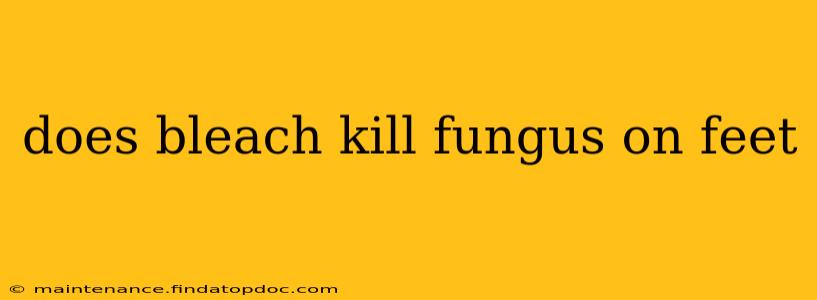Athlete's foot, medically known as tinea pedis, is a common fungal infection affecting the feet. Many people wonder if bleach can effectively kill this stubborn fungus. While bleach is a powerful disinfectant, its use on the skin, especially the delicate skin of the feet, is strongly discouraged. This article explores why bleach isn't the solution and outlines safer and more effective treatment options.
Why Bleach Isn't Suitable for Treating Athlete's Foot
Bleach is a harsh chemical designed to kill bacteria and viruses on surfaces, not living tissue. Applying bleach directly to your feet can lead to several serious problems:
- Severe skin irritation: Bleach can burn and irritate the skin, causing redness, itching, and pain. This can worsen the existing condition and delay healing.
- Chemical burns: Concentrated bleach can cause chemical burns, leading to scarring and potential long-term damage.
- Increased risk of infection: Damaged skin from bleach is more susceptible to secondary bacterial infections, further complicating treatment.
Therefore, using bleach to treat athlete's foot is highly risky and ineffective. It won't kill the fungus effectively and will likely cause more harm than good.
What are the Effective Treatments for Athlete's Foot?
Several effective and safe methods treat athlete's foot. The best approach depends on the severity of the infection:
-
Over-the-counter antifungal creams and sprays: These are readily available at most pharmacies and are often sufficient for mild cases. Look for ingredients like clotrimazole, miconazole, or terbinafine. Always follow the instructions on the packaging.
-
Prescription antifungal medications: For more persistent or severe cases, a doctor may prescribe stronger oral or topical antifungal medications. These are typically more potent and effective than over-the-counter options.
-
Home remedies: Some home remedies can help manage symptoms and create a less hospitable environment for the fungus. These include:
- Keeping feet clean and dry: This is crucial in preventing fungal growth. Wash your feet daily with mild soap and water and thoroughly dry them, especially between the toes.
- Wearing breathable socks and shoes: Avoid wearing tight-fitting shoes or socks made from synthetic materials, which trap moisture. Opt for cotton or other breathable fabrics.
- Using antifungal powders: These can help absorb moisture and prevent fungal growth.
Can I Use Bleach to Clean My Shoes and Socks?
While you shouldn't use bleach directly on your feet, you can use diluted bleach to disinfect your shoes and socks. This can help prevent reinfection. However, always follow these precautions:
- Dilute the bleach: Use a solution of 1 part bleach to 10 parts water.
- Test in an inconspicuous area: Before applying the solution to the entire item, test it on a small, hidden area to ensure it doesn't damage the material.
- Rinse thoroughly: After cleaning, rinse the items thoroughly with clean water and allow them to air dry completely.
- Do not use on all materials: Some materials, like leather, may be damaged by bleach.
How Can I Prevent Athlete's Foot?
Preventing athlete's foot is often easier than treating it. Here are some preventative measures:
- Maintain good foot hygiene: Wash and dry your feet thoroughly daily.
- Wear clean socks: Change your socks regularly, especially if they become sweaty.
- Avoid walking barefoot in public places: This includes locker rooms, showers, and swimming pools.
- Wear appropriate footwear: Choose shoes that are well-ventilated and allow your feet to breathe.
- Treat underlying conditions: Conditions like hyperhidrosis (excessive sweating) can increase the risk of athlete's foot. Addressing these conditions can help prevent infection.
What are the Symptoms of Athlete's Foot?
Recognizing the symptoms early can help you seek treatment promptly:
- Itching: This is often the first symptom.
- Burning or stinging: Especially between the toes.
- Redness and inflammation: The skin may appear red, swollen, and inflamed.
- Cracking and scaling: The skin may crack and peel, particularly around the heels and toes.
- Blisters: These can be filled with clear or yellowish fluid.
This information is for general knowledge and does not constitute medical advice. If you suspect you have athlete's foot, consult a doctor or dermatologist for proper diagnosis and treatment. They can assess your specific situation and recommend the most appropriate course of action.
